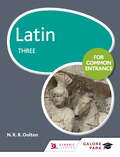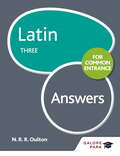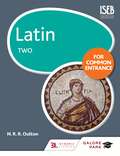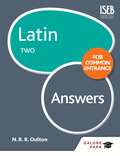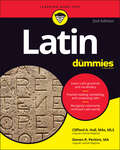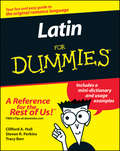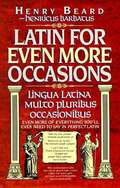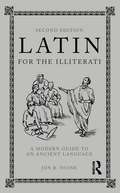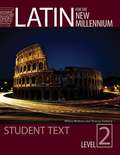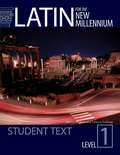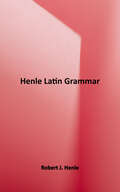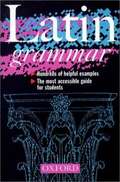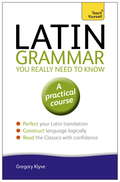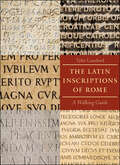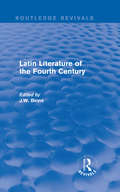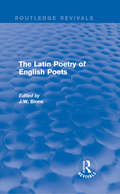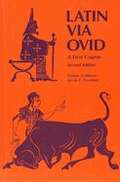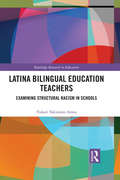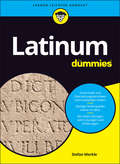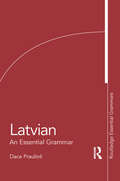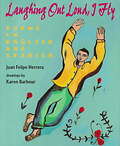- Table View
- List View
Latin for Common Entrance Three
by N. R. OultonExam Board: ISEBLevel: 13+Subject: LatinFirst Teaching: September 2014First Exam: Autumn 2015Latin for Common Entrance Three is the final book in Nicholas Oulton's new Latin course, combining your favourite elements of So You Really Want to Learn Latin, Latin Prep and Ab Initio, but now it maps precisely to the new ISEB syllabus and contains passages and question types in line with the revised Common Entrance exam.Following on from Book Two, this extensively revised book takes pupils through the passive voice, imperfect subjunctive, participles, relative clauses, purpose clauses, indirect commands, 5th declension nouns and expressions of time. Everything required for Common Entrance Level 3 is covered, including a brief treatment of the last remaining topics of the non-linguistic studies element of the ISEB syllabus.Latin for Common Entrance Three Answers are available to buy separately as a PDF download.
Latin for Common Entrance Three Answers
by N. R. OultonThis PDF download provides a complete set of answers to the exercises in Latin for Common Entrance Three.- Clear layout saves time marking work - Enables efficient assessment of pupils' strengths and weaknesses - Advice and guidance develops pupils' use of the language
Latin for Common Entrance Three Answers
by N. R. OultonThis PDF download provides a complete set of answers to the exercises in Latin for Common Entrance Three.- Clear layout saves time marking work - Enables efficient assessment of pupils' strengths and weaknesses - Advice and guidance develops pupils' use of the languagePlease note that as a PDF download, this product is non-refundable.
Latin for Common Entrance Two
by N. R. OultonLatin for Common Entrance Two is the second book in Nicholas Oulton's new Latin course, combining your favourite elements of So You Really Want to Learn Latin, Latin Prep and Ab Initio, but now it maps precisely to the new ISEB syllabus and contains passages and question types in line with the revised Common Entrance exam.Following on from Book One, this extensively revised book takes pupils through the future and pluperfect tenses, 3rd declension nouns and adjectives, personal and demonstrative pronouns, the comparison of adjectives and irregular verbs. All the grammar, vocabulary and syntax on the Level 2 syllabus is covered and it also covers a substantial portion of the non-linguistic studies part of the ISEB syllabus in the areas of Greek mythology, Domestic Life and the City of Rome.Written specifically for prep schools, this book includes solid grammar explanations, intentionally challenging content and twice as many practice exercises compared to the previous series, ensuring pupils have understood the material covered.
Latin for Common Entrance Two
by N. R. OultonExam Board: ISEBLevel: 13+Subject: LatinFirst Teaching: September 2014First Exam: Autumn 2015Latin for Common Entrance Two is the second book in Nicholas Oulton's new Latin course, combining your favourite elements of So You Really Want to Learn Latin, Latin Prep and Ab Initio, but now it maps precisely to the new ISEB syllabus and contains passages and question types in line with the revised Common Entrance exam.Following on from Book One, this extensively revised book takes pupils through the future and pluperfect tenses, 3rd declension nouns and adjectives, personal and demonstrative pronouns, the comparison of adjectives and irregular verbs. All the grammar, vocabulary and syntax on the Level 2 syllabus is covered and it also covers a substantial portion of the non-linguistic studies part of the ISEB syllabus in the areas of Greek mythology, Domestic Life and the City of Rome.Written specifically for prep schools, this book includes solid grammar explanations, intentionally challenging content and twice as many practice exercises compared to the previous series, ensuring pupils have understood the material covered. Latin for Common Entrance Two Answers are available to buy separately as a PDF download.
Latin for Common Entrance Two Answers
by N. R. OultonThis PDF download provides a complete set of answers to the exercises in Latin for Common Entrance Two.- Clear layout saves time marking work - Enables efficient assessment of pupils' strengths and weaknesses - Advice and guidance develops pupils' use of the languagePlease note that as a PDF download, this product is non-refundable.
Latin For Dummies
by Clifford A. Hull Steven R. PerkinsMaster the basics of a lyrical and useful language Even though most people don’t use Latin anymore, it used to be spoken by millions of people from across the ancient world. It later morphed into new languages we still use today! In Latin For Dummies, you’ll take a tour through the language of ancient Rome. Beginning with Latin you may already know, like “carpe diem” and “quid pro quo,” the book walks you through essential Latin grammar and everyday Latin phrases. It also explores how Latin shaped and molded modern languages, including English. In this book, you’ll find: Lessons to learn Latin grammar and vocabulary Practices for reading, translating, and composing Latin Tips to recognize commonly confused Latin words Latin For Dummies proves that learning Latin, while challenging, can be fun and exciting too! It’s perfect for first timers interested in the ancient language and anyone who wants to learn more about ancient Roman history and culture.
Latin For Dummies
by Clifford A. Hull Steven R. Perkins Tracy BarrEarn-lay atin-Lay? No, not that kind of Latin! You can learn true Latin, with conjugations, declensions, and all those extra syllables - and it's easier than you think. In fact, most people mistakenly think of learning Latin as perhaps the most useless, tedious, and difficult thing to do on earth. They couldn't be more wrong. Latin For Dummies takes you back for a quick jaunt through the parlance of ancient Rome, as well as discussing the progress of Latin into church language, and its status today as the "dead" language that lives on in English, Spanish, Italian, and most other Western tongues. Written for those with zero prior knowledge of Latin, this snappy guide puts the basics at your fingertips and steers clear of the arcane, schoolmarm stereotype of endless declensions and Herculean translations. Easy-to-understand sections describe: Latin you already know Grammar Pronunciation Latin in action Latin in law Latin in medicine Latin for impressing your friends And much more No dusty tome or other such artifact, Latin For Dummies makes learning fun and brings the language to life by presenting conversations in various Roman settings, as well as providing fun facts and stories about classical life. And if you feel you may actually have a negative aptitude for the language, don't worry; pronunciations and translations follow every expression, and a helpful mini-dictionary graces the book's last pages. You'll also find out about: The quotable Roman Latin graffiti Latin authors who's who Gladiator Latin Latin in love, marriage, and family From the mouth of Julius Caesar Romans on drink Helpful Latin-related Web sites Fun and games exercises Designed to introduce and familiarize you with the language rather than make you the next Cicero, Latin For Dummies gives you all the tools you need to work at your own pace to learn as much or as little as you like. So noli timere (no-lee tih-may-reh) - "have no fear" - and carpe diem ("pick up Latin For Dummies today")!
Latin for Even More Occasions: Lingua Latina Multo Pluribus Occasionibus
by Henry BeardMore English expressions translated into Latin, including "Please don't squeeze the Charmin", "Erin go bragh" and "Make my day."
Latin for the Illiterati: A Modern Guide to an Ancient Language
by Jon R. StoneThis revised and updated edition includes a brand new foreword by Richard LaFleur and more than fifteen hundred new entries and abbreviations. Organized alphabetically within the categories of verba (common words and expressions), dicta (common phrases and familiar sayings), and abbreviations, this practical and helpful reference guide is a comprehensive compendium of more than 7,000 Latin words, expressions, phrases, and sayings taken from the world of art, music, law, philosophy, theology, medicine and the theatre, as well as witty remarks and sage advice from ancient writers such as Virgil, Ovid, Cicero, and more.
Latin for the New Millennium Student Text, Level 1
by Milena Minkova Terence TunbergNIMAC-sourced textbook
Latin Grammar (Henle Latin)
by Robert J. HenleHenle Latin Grammar is designed for student use through all four years of Latin study: Part I introduces forms of nouns, adjectives, adverbs, numerals, pronouns, and verbs; Part II covers syntax. Humanistic insight and linguistic training are the goals of the Henle Latin Series from Loyola Press, an integrated four-year Latin course. Time-tested and teacher-endorsed, this comprehensive program is designed to lead the student systematically through the fundamentals of the language itself and on to an appreciation of selected classic texts.
A Latin Grammar
by James MorwoodA Latin Grammar gives clear, concise, and easily understood explanations of all the key points of Latin grammar. With additional features such as a glossary of grammatical terms, a vocabulary list covering all the Latin words found in the main text, study tips, and notes on Roman dates, money, weights and measures, and names, it ensures that students have all the support they need to complement their language learning. A Latin Grammar also offers hundreds of example sentences illustrating grammatical points, an explanation of literary terms, and an invaluable guide to pronunciation. This handy reference helps students bring this influential language to life.
Latin Grammar You Really Need to Know: Teach Yourself
by Gregory KlyveComprehensive and clear explanations of key grammar patterns and structures are reinforced and contextualized through authentic materials. You will not only learn how to construct grammar correctly, but when and where to use it so you sound natural and appropriate. Latin Grammar You Really Need to Know will help you gain the intuition you need to become a confident communicator in your new language.
Latin Grammar You Really Need to Know: Teach Yourself
by Dr Gregory KlyveComprehensive and clear explanations of key grammar patterns and structures are reinforced and contextualized through authentic materials. You will not only learn how to construct grammar correctly, but when and where to use it so you sound natural and appropriate. Latin Grammar You Really Need to Know will help you gain the intuition you need to become a confident communicator in your new language.
The Latin Inscriptions of Rome: A Walking Guide
by Tyler LansfordRome’s oldest known Latin inscription dates from the sixth century BC; the most recent major specimen was mounted in 2006—a span of more than two and a half millennia. Remarkably, many of these inscriptions are still to be found in situ, on the walls, gates, temples, obelisks, bridges, fountains, and churches of the city. Classicist Tyler Lansford has collected some 400 of these inscriptions and arranged them—with English translations—into fifteen walking tours that trace the physical and historical contours of the city. Each itinerary is prefaced by an in-depth introduction that provides a survey of the history and topography of the relevant area of the city. The Latin texts appear on the left-hand page with English translations on the right. The original texts are equipped with full linguistic annotation, and the translations are supplemented with historical and cultural notes that explain who mounted them and why.This unique guide will prove a fascinating and illuminating companion for both sophisticated visitors to the Eternal City and armchair travelers seeking a novel perspective into Rome's rich history.
The Latin Inscriptions of Rome: A Walking Guide
by Tyler LansfordA collection of 15 guided walking tours of the ancient Latin descriptions found throughout Rome. Rome&’s oldest known Latin inscription dates from the sixth century BC; the most recent major specimen was mounted in 2006—a span of more than two and a half millennia. Remarkably, many of these inscriptions are still to be found in situ, on the walls, gates, temples, obelisks, bridges, fountains, and churches of the city. Classicist Tyler Lansford has collected some 400 of these inscriptions and arranged them—with English translations—into fifteen walking tours that trace the physical and historical contours of the city. Each itinerary is prefaced by an in-depth introduction that provides a survey of the history and topography of the relevant area of the city. The Latin texts appear on the left-hand page with English translations on the right. The original texts are equipped with full linguistic annotation, and the translations are supplemented with historical and cultural notes that explain who mounted them and why. This unique guide will prove a fascinating and illuminating companion for both sophisticated visitors to the Eternal City and armchair travelers seeking a novel perspective into Rome's rich history.&“This book is wonderful. . . . Lansford&’s evocative depictions of monuments, cityscape, and memorable humans have inspired me anew with the fascination of Rome.&” —Mary T. Boatwright, Duke University&“If this book is not slipped into many a Rome-bound suitcase, there is no justice in the world. I can think of few more enjoyable companions on a prowl through the city.&” —Jane Stevenson, Times Literary Supplement (UK)
Latin Literature of the Fourth Century (Routledge Revivals)
by J. W. BinnsThis volume, offering an insight into the literary world of Rome in the fourth century AD, reflects an increased interest in the writers of the 150 years before the collapse of the Western Empire, who have long been over-shadowed by the pre-eminence accorded since the eighteenth century to the Golden and Silver ages. Among the writers examined are Ausonius, the poet, Imperial official and tutor to Gratian; Claudian, the last major ‘classical’ poet; Prudentius, and Paulinus of Nola, two of the founders of Christian Latin poetry; Symmachus, the letter writer and supporter of die-hard paganism; and St. Augustine, whose influence on Christian thought and the Middle Ages is incalculable. These essays consider how such writers responded to a world where vitality was ebbing from the old forms of political life, religion and literature, giving way to new institutions, modes of life and horizons of reflection.
The Latin Poetry of English Poets (Routledge Revivals)
by J. W. BinnsThomas Campion, Milton, Crashaw, Herbert, Bourne, Walter Savage Landor – all these poets, between them spanning the period from the Elizabethan to the Victorian age, wrote a substantial body of Latin verse in addition to their better-known English poetry, representing part of the vast and almost unexplored body of Neo-Latin literature which appealed to an international reading public throughout Europe. The Latin poetry of these English poets is of particular interest when it is set against the background of their writings in their own tongue: this collection examines the extent to which our judgment of a poet is altered by an awareness of his Latin works. In some we find prefigured themes which were later treated in their English verse; others wrote Latin poetry throughout their lives and give evidence in their Latin poetry of interests which do not find expression in their English compositions. This volume is a valuable resource for students of both Latin and English literature.
Latin Via Ovid: A First Course
by Norma Goldman Jacob E. NyenhuisUsing an introduction to mythology by the master storyteller Ovid himself, the authors have prepared a unique teaching tool designed to achieve proficiency at Latin in one year at the college level, two years at the high school or intermediate level. The volume provides students with imaginative, connected reading, beginning with introductory prose versions of Ovid's simple myth tales and progressing to the rich poetry of Ovidian Latin (with appropriate teaching aids) within forty lessons. <p><p>The grammatical approach is traditional, but the central emphasis is on reading. In each chapter the reading appears first, followed by the vocabulary, the grammar, exercises, and etymology relating to the vocabulary. The exercises begin with a group of questions in Latin (based on the reading), to be answered in Latin. Each tale is preceded by a brief discussion in English of the story and its mythological significance. The myths retold by Ovid and the attractive format are conceived to impel the student into acquiring the skill to read the author in the original language.
Latina Bilingual Education Teachers: Examining Structural Racism in Schools (Routledge Research in Education #22)
by Yukari Takimoto AmosUsing critical race theory and whiteness studies as theoretical frameworks, this book traces two Latina bilingual education teachers in three different professional phases: as paraprofessionals, teacher candidates, and certified teachers. Grounded in a longitudinal case study, this book sheds light on the effects of institutional racism when Latina/o educational professionals attempt inclusion in white dominant organizations, such as schools. Revealing and analyzing the structural racism present in schools and the obstacles it creates for professionals of color, the author exposes the racist practices that are hidden from view and offer practical solutions to combat them.
Latinum für Dummies (Für Dummies)
by Stefan MerkleGehören auch Sie zu den Studierenden, die an der Uni das Latinum nachholen müssen, weil es eine Voraussetzung für Ihren Abschluss ist, Sie aber in der Schule Latein nicht belegt hatten? Da gibt es sicher Angenehmeres. Aber wenn Sie schon im Lateinkurs sitzen, sollte das Lernen zumindest Spaß machen. Dieses Buch bereitet Sie auf die Klausur vor und hilft Ihnen, sie zu bestehen, auch wenn Sie zuvor keine Lateinkenntnisse hatten. Schritt für Schritt führt Stefan Merkle Sie in die lateinische Grammatik ein. Der Autor weiß, wo es hakt und welche grammatischen Formen besonders knifflig sind. Er vermittelt Übersetzungstechniken und weist Sie auf die häufigsten Fehlerquellen hin. Und nach den nachvollziehbaren Erklärungen heißt es dann üben, üben, üben - getreu dem Motto von null bis Caesar!
Latvian: The Complete Course For Beginners (Routledge Essential Grammars)
by Dace PraulinšLatvian: An Essential Grammar is a concise, user-friendly guide to the basic grammatical structures of Latvian. Presenting a fresh and accessible description of the language, this engaging grammar uses clear, jargon-free explanations to set out the complexities of Latvian in short, readable sections. Key features include: clear grammar explanations frequent use of authentic examples pronunciation guide, bibliography and subject index. This is the ideal reference source both for those studying Latvian independently and for students in schools, colleges, universities and adult classes of all types to back up their studies.
Laughing Out Loud, I Fly: A Carcajadas Yo Vuelo
by Juan Felipe HerreraA collection of poems in Spanish and English about childhood, place, and identity.
